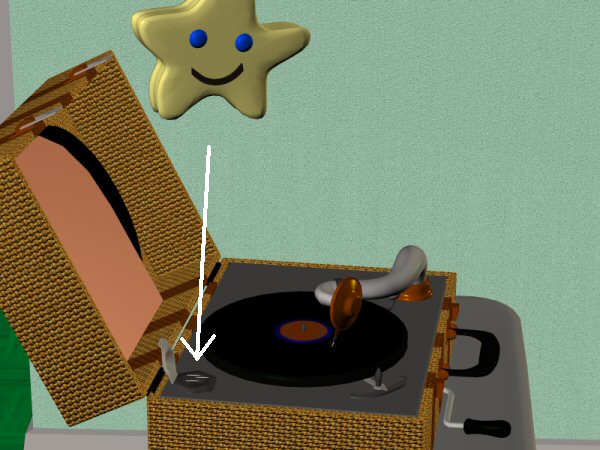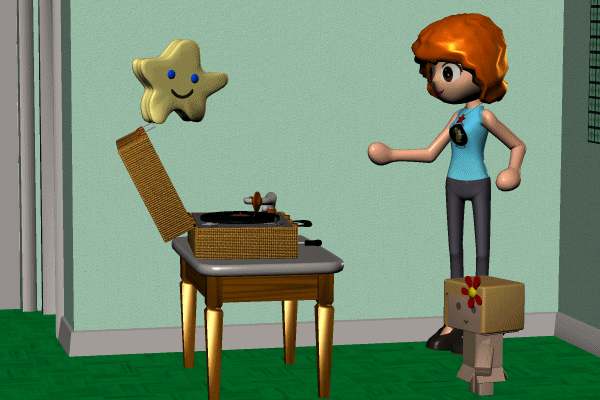Tuesday, May 19, 2020
The last windup phono
Here's the second item in Ancestral Phonos, following on Poulsen's original wire recorder. I was going to do the Dictaphone next, but it didn't grab my interest. I've mentioned this one before and always wanted to animate it.
The Birch windup phonograph was the last non-electric phono, made well into the 1950s. It adopted the '50s look without adopting electricity. A true Patient Machine.
What I really wanted to show in this device is the Needle Vault,
 a miniature storehouse for spare needles. The lid also had a hinged flap to hold your current 'playlist' of records, so the Birch was fully self-contained, needing no external power or external supplies.
Now we'll let Polistra and friends have some off-grid '50s fun with the Birch!
a miniature storehouse for spare needles. The lid also had a hinged flap to hold your current 'playlist' of records, so the Birch was fully self-contained, needing no external power or external supplies.
Now we'll let Polistra and friends have some off-grid '50s fun with the Birch!
 = = = = =
I've learned to appreciate the power of clockwork. It's completely independent of all systems that can be turned off by governments or disasters. If you're alive enough to use the device, you're alive enough to wind it up. If you're not alive, it doesn't matter.
Oddly, modern technology makes more windup devices possible. A phono doesn't need electronics, but a radio does. Solid-state circuitry consumes much less power than tubes, so a radio with a windup generator is practical.
Existing cranked radios fail the independence test because they use a cranked generator to store energy in a lithium battery. Lithium batteries have a SHORT shelf life. I tried a cranked radio and a cranked flashlight. Both failed after two years. The lithium cells were soldered in, so even if you were buying spare cells once a year, you couldn't solder the new one without electricity!
A generator turned by clockwork and directly powering the radio would always be ready when you need it.
= = = = =
I've learned to appreciate the power of clockwork. It's completely independent of all systems that can be turned off by governments or disasters. If you're alive enough to use the device, you're alive enough to wind it up. If you're not alive, it doesn't matter.
Oddly, modern technology makes more windup devices possible. A phono doesn't need electronics, but a radio does. Solid-state circuitry consumes much less power than tubes, so a radio with a windup generator is practical.
Existing cranked radios fail the independence test because they use a cranked generator to store energy in a lithium battery. Lithium batteries have a SHORT shelf life. I tried a cranked radio and a cranked flashlight. Both failed after two years. The lithium cells were soldered in, so even if you were buying spare cells once a year, you couldn't solder the new one without electricity!
A generator turned by clockwork and directly powering the radio would always be ready when you need it.
 a miniature storehouse for spare needles. The lid also had a hinged flap to hold your current 'playlist' of records, so the Birch was fully self-contained, needing no external power or external supplies.
Now we'll let Polistra and friends have some off-grid '50s fun with the Birch!
a miniature storehouse for spare needles. The lid also had a hinged flap to hold your current 'playlist' of records, so the Birch was fully self-contained, needing no external power or external supplies.
Now we'll let Polistra and friends have some off-grid '50s fun with the Birch!
 = = = = =
I've learned to appreciate the power of clockwork. It's completely independent of all systems that can be turned off by governments or disasters. If you're alive enough to use the device, you're alive enough to wind it up. If you're not alive, it doesn't matter.
Oddly, modern technology makes more windup devices possible. A phono doesn't need electronics, but a radio does. Solid-state circuitry consumes much less power than tubes, so a radio with a windup generator is practical.
Existing cranked radios fail the independence test because they use a cranked generator to store energy in a lithium battery. Lithium batteries have a SHORT shelf life. I tried a cranked radio and a cranked flashlight. Both failed after two years. The lithium cells were soldered in, so even if you were buying spare cells once a year, you couldn't solder the new one without electricity!
A generator turned by clockwork and directly powering the radio would always be ready when you need it.
= = = = =
I've learned to appreciate the power of clockwork. It's completely independent of all systems that can be turned off by governments or disasters. If you're alive enough to use the device, you're alive enough to wind it up. If you're not alive, it doesn't matter.
Oddly, modern technology makes more windup devices possible. A phono doesn't need electronics, but a radio does. Solid-state circuitry consumes much less power than tubes, so a radio with a windup generator is practical.
Existing cranked radios fail the independence test because they use a cranked generator to store energy in a lithium battery. Lithium batteries have a SHORT shelf life. I tried a cranked radio and a cranked flashlight. Both failed after two years. The lithium cells were soldered in, so even if you were buying spare cells once a year, you couldn't solder the new one without electricity!
A generator turned by clockwork and directly powering the radio would always be ready when you need it. Labels: Patient things, storage
